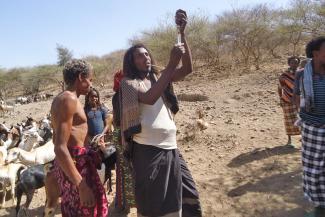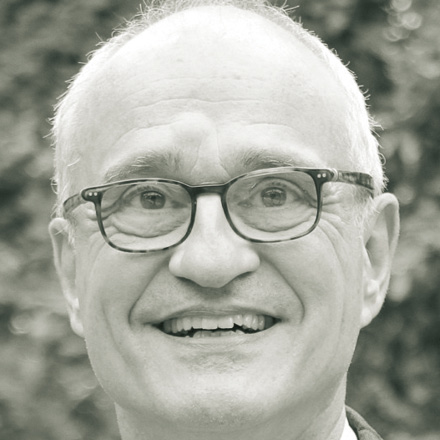Paramedics
From the community, for the community
 Esmael Tessema
Esmael Tessema
Para-veterinary professionals deliver important services in Africa, especially in arid and semi-arid regions. It is well documented that rural communities benefit from animal-health workers who, though they have no university degree, have had some kind of systematic training. Training courses vary from a few weeks to three years or more.
A subgroup of the veterinary paramedics are community-based animal-health workers (CAHWs). They are community members who have received basic, non-formal training in animal-health care. They engage in the prevention and treatment of animal diseases. Prevention basically means vaccination in this context. CAHWs have played an important role in extending veterinary services particularly in East Africa, as well as in countries like Bolivia, Nepal and Sri Lanka.
In the Horn of Africa, CAHWs were first trained in the 1980s. Training programmes have since been scaled up in response to livestock owners’ growing demand for their services. Government policies played a role too, reflecting a general shift towards community-based approaches in development affairs.
At first, scepticism was the general response to training community members to deliver basic animal-health services in underserved, remote and conflict-torn areas. That changed in view of the CAHWs’ substantial achievements. They are especially important in places where no other veterinary services are available. Formally-trained experts hardly work in Africa’s most remote regions and war zones. The CAHW approach has therefore been increasingly appreciated and supported. Unfortunately, that is not so everywhere. Kenya, for instance, does not recognise CAHWs as relevant agents of animal-health service.
An important success that CAHWs contributed to, was the eradication of rinderpest, which is also called cattle plague or steppe murrain. This disease had devastating impacts on the cattle business all over the world. For decades, attempts were made to eradicate it, but rinderpest hotspots endured in the Horn of Africa.
Things only improved once CAHWs became involved in the eradication drive in Ethiopia, Somalia and South Sudan. The CAHWs carried out several rounds of vaccination. Somalia was the last country to become free of rinderpest, and in 2010, rinderpest was officially declared to be eradicated.
Since the 1990s, CAHWs in Eastern Africa have been supported by VSF Germany, a non-governmental organisation. VSF stands for Vétérinaires sans Frontières (veterinarians without borders). VSF Germany scaled up its CAHW programme during the rinderpest-eradication campaign. Currently, they are cooperating with CAHWs in several east African countries.
Ethiopian achievements
VSF Germany is running animal-health projects in Ethiopia, where drought has become a defining feature of life for lowland communities. The impacts include the loss of productive assets and worsening food insecurity. Food insecurity is a challenge in several Ethiopian states.
In Afar, for example, pastoralists’ livestock population is in decline. As rainfall has become more erratic, productivity is suffering. Land degradation, the invasion of Prosopis juliflora (a kind of bush-weed) and the fast growth of the human population add to the problems. Compounding matters, pastoralists lack access to markets and are increasingly denied access to land that is now used for farming. In this region, VSF Germany is implementing various livelihood projects in a number of districts, which are called woredas in Ethiopia.
The Ethiopian veterinary service has a long history of supporting CAHWs. In 2002, CAHWs were officially recognised as relevant service providers. The government has set up a unit for CAHWs in the Ministry of Agriculture and Rural Development. It has also defined minimum standards and guidelines for CAHW projects. CAHWs are being trained systematically, and there is a training-of-trainers system. In this context, VSF Germany has set up an innovative voucher scheme in support of CAHWs in eight woredas (see box next page). We want to increase the sustainability of veterinary services especially in remote pastoral areas of Afar.
Relevant progress
In the past decade, important progress has been made in the institutionalisation of CAHWs. It makes sense to regulate and standardise the CAHW programme as Ethiopia is doing. Similar attempts have been made in South Sudan and Somalia, and they make the work of VSF Germany more effective and sustainable.
It is unfortunate that not all countries appreciate the role of CAHWs. Kenya, for example, passed legislation to regulate the animal-health sector in 2011 without recognising any role for CAHWs. VSF Germany is active in Kenya too, but in the lack of an appropriate legal framework, it is extremely challenging to provide sustainable, affordable and accessible animal-health services to poor pastoralist communities there.
Genene Regassa is the country director of VSF Germany in Ethiopia.
Esmael Tessema is a programme manager for VSF Germany in Ethiopia.
esmael@vsfg.org
Nicoletta Buono is head of programmes at VSF Germany in Ethiopia.
buono@vsfg.org
Cornelia Heine is an adviser on pastoralists at VSF Germany, and, like her co-authors, a veterinarian.
cornelia.heine@togev.de

